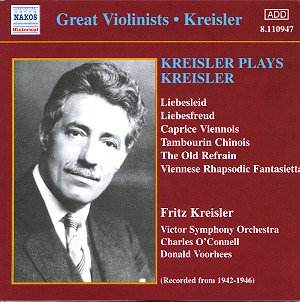These are among Kreislerís last recordings. His May
1945 recording of the Concerto in C in the style of Vivaldi has already
been issued by Naxos (8.110922) and a few off-air broadcasts from 1943-45
have also appeared, mostly from the Bell Telephone Hour. None adds substantially
to his discography.
At 67 Kreislerís career was on the wane, exacerbated
by appalling injuries he sustained whilst crossing a New York street
in 1941 (a picture of the violinist, bloody and dazed, is reproduced
in Amy Biancolliís recent biography and makes for grim viewing). He
had recovered in time to record the first session on this CD, in arrangements
made by himself, in Philadelphia in January 1942. It would be idle to
suggest that Kreisler had emerged unscathed from the vicissitudes that
afflict any artist in his sixties; nor that his technical armoury was
entirely intact. The flatness of pitch in the higher registers of the
E string makes itself uncomfortably present on a few occasions (he seems
always to have played flat rather than sharp) and other blemishes, generally
minor, manifest themselves. The Kreisler tone of 1941, whilst still
beautiful, was not the ravishingly vibrant one of 1912.
We are, however, lucky to have these recordings at
all and can appreciate his miraculous rhythmic faculties Ė his rubato
is still an object lesson in phrasing. Listening to the extraordinary
flexibility of his 1942 Tambourin Chinois, a piece he had already recorded
five times in his career, is to wonder again at his musical daring and
inevitable rightness. His tempi are as deliberate as ever, his double-stopping
is admirably true, his portamenti are quick and subtle, his performances
affectionate and generous. In the somewhat boxy acoustic of the Academy
of Music a section of the Philadelphia Orchestra (contractually here
called the Victor Symphony Orchestra) plays a selection of his favourites.
The piquant arrangements are Kreislerís and feature drums, a glistening
harp, fey Celeste, woodwind shadowing the melody line, some surging
string tone and a confection of highly spiced Kreisleriana. In Caprice
viennois, a piece he had recorded six times, we can hear that rather
twee Celeste, as well as Kreislerís own supreme sovereignty of rubato.
That rhythmic licence and élan can fully be appreciated in the
Tambourin chinois where the middle section is superbly flexible. A little,
appropriate, tambourine crash adds to the excitement, as does Kreislerís
own word of pleasure at the end - "beautiful".
Elsewhere many distinguishing features of an elite
musicianís art can be savoured Ė the way he varies with infinite skill
the repeated phrases of Liebesfreud, the apposite decorations in Heubergerís
Midnight Bells, the way he allows the woodwind an imitative trill in
his arrangement of the Marche miniature viennoise, the beautiful bowing
in the Chanson Louis X111 and Pavane. Of course frailties co-exist with
his extraordinary musicality Ė the thinning tone, especially in the
Viennese Rhapsodic Fantasietta composed especially for the 1946 New
York sessions, the high position slips in the Heuberger, the flatness
of intonation.
Nevertheless these performances capture a great artist
in his final years and, if hardly representative of his best years,
they still allow us to savour those many qualities that had led him
to revolutionize violin playing and galvanize two generations of musicians.
The transfers are good and the notes, by Tully Potter, equally so.
Jonathan Woolf

![]() Fritz Kreisler (1875-1962)
violin with
Fritz Kreisler (1875-1962)
violin with ![]() NAXOS HISTORICAL 8.110947
[60.06]
NAXOS HISTORICAL 8.110947
[60.06]